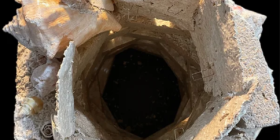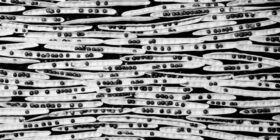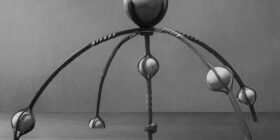Mistaken Identity
Since the early 1990s, Paul Vanouse’s artwork has addressed complex issues raised by varied new techno-sciences using these very techno-sciences as a medium. His artworks have included data collection devices that examine the ramifications of polling and categorization, genetic experiments that undermine scientific constructions of race and identity, and temporary organizations that playfully critique institutionalization and corporatization. These “Operational Fictions” are hybrid entities–simultaneously real things and fanciful representations–intended to resonate in the equally hyper-real context of the contemporary electronic landscape.

Paul Vanouse, Latent Figure Protocol, performance, Transmediale, Berlin, 2011.
INTRODUCTION:
Impassioned amateurism and radical interdisciplinarity guide my artistic experiments with emerging media forms. Emerging media forms are those which have not yet become expected nor accepted means of expression nor communication, thus their mediation is never transparent, but rather heavily laden by their own form and materiality. When viewing bio-media artworks, for instance, any specific interpretations of the work are made in relation to the liveness, ephemerality, viscerality, inscrutability or the technical and scientific nature of the work itself.
Most of my bio-media projects use actual DNA as both a medium of expression, as well as a subject of investigation. This focus on the materiality and properties of DNA has allowed these projects to push the representational power of their medium. To make the DNA visible to audiences, I work with a process called DNA electrophoresis, sometimes referred to as “DNA Fingerprinting,” a scientific process that induces DNA to separate into banding patterns that have become highly authoritative and iconic of identity itself. Yet my projects use such DNA technologies differently than in typical lab practice as I believe that artists working in emerging technologies should go beyond use of only pre-existing techniques and through creative re-use, mis-use and/or even ab-use turn them into communicative media forms.
For twenty years, my practice has been dedicated to challenging the cultural authority of DNA and genetic identity, that is epitomized in slogans like “you are your DNA” and “DNA is destiny.” Such reductive slogans are rooted in deeply-rooted systemic social repression and colonial practices. My current project Labor uses living bacteria of the human epidermis, but stems from my earlier work on genetic identity, as it is clear that bacterial, non-human life helps to create our olfactory identity. Indeed, the importance of our microbiome in nearly all bodily functions, from digestion to cognition, undermines the reductive omnipotence granted DNA in the early 2000s.
My work always has a public in mind and I try to create situations that are dynamic, provocative and that differ from the public’s expectations of art—whether through utilizing less-recognized installation format such as a scientific experiment, or building multi-sensory installations that privilege the olfactory over auditory and visual sensation. In these installations, viewers co-inhabit spaces with living microbes and deep material processes. The sounds include only those emanating from the pumps, heaters, coolers and equipment necessary to sustain these processes. The scents are likewise produced by the organisms and processes themselves. My work utilizes emerging media forms and unconventional methods of public display to challenge entrenched cultural concepts of racial identity, individual identity, national identity and human identity.

Paul Vanouse, Relative Velocity Inscription Device, installation, Schering Foundation, Berlin, 2011. Photo: Axel Heise.
RACIAL IDENTITY:
In the year 2000, a team of UNESCO scientists declared, “There is no scientific basis for race.” The statement was made following the completion of the rough draft of the human genome project. Many people, like me, breathed a collective sigh of relief as the Human Genome Project, a massive international endeavor to map every gene in human DNA, had marked a return to scientific study of the genetic basis of human identity not investigated since the eugenics movement of the early 1900s. The UNESCO statement followed findings that there were more genetic differences within the so-called races, than between them. However, I pessimistically believed that racism could exist, even if race did not. I surmised that concepts of race would simply go molecular alongside external markers of difference like skin and hair.
The Relative Velocity Inscription Device (RVID) is a bio-media installation using DNA of my “bi-racial” family members of Jamaican descent. (A century ago, Jamaica was the site of an infamous Eugenic study called Race Crossing in Jamaica, to assess the aptitudes of bi-racial people.) RVID is an experimental race, about race. To complete the artwork, I first had skin color gene DNA extracted[i] from the blood of my family: “white” father, “black” mother, “brown” sister, “brown” brother (myself)[ii]. Since there were six genes understood to effect skin color, each family member had six different associated DNA fragments. Each week during gallery exhibitions, museum staff insert one of the six individual DNA samples in the four lanes of a large DNA electrophoresis rig. Electrophoresis is a process that is typically used to separate DNA by size, resulting in a distinct banding pattern often referred to as a DNA Fingerprint. In RVID however, I repurpose the technology to literally race the different family member DNA fragments against one another, to poetically and ironically determine their “genetic fitness”. The DNA fragments slowly move through the gel over the course of several days during each gallery installation and the bands are visible to audiences both in the gel and on a large central projection. The computer-regulated installation automates many components of the experiment such as electrifying the gel, cooling the gel rig, switching on UV lights to make the DNA visible, capturing the image and even analyzing the results using machine vision algorithms to determine the velocity of each family member’s DNA.
RVID is intended to highlight the ominous return of human genetics in the Human Genome Project. The DNA race is an elaborate pun on the Eugenics idea of “genetic fitness”, but using a contemporary DNA technology of gel electrophoresis. Audiences experience the work as a live, dynamic process unfolding—the inscription of DNA into the construction of race.
Relative Velocity Inscription Device, video.

Paul Vanouse, Relative Velocity Inscription Device, digital still based on interactive installation computer feed, 2007.

Paul Vanouse, Latent Figure Protocol, installation, Transmediale, Berlin, 2011. Photo: Axel Heise.
INDIVIDUAL IDENTITY:
Latent Figure Protocol (LFP), probes further into the meanings of the DNA image: Why is it called a DNA Fingerprint? After all DNA used to make these images doesn’t usually come from a finger. Nor is the DNA image a physical imprint, but rather it is a complex laboratory procedure. An FBI director stated in the 1990s that they use the term DNA fingerprinting because it “invokes in the mind of a jury that we are identifying one individual to the exclusion of all others”. They use the term DNA fingerprinting metaphorically to emphasize a connection to actual fingerprints, external markers of unchanging surface differences between individuals, that have been accepted in courts for nearly one hundred years.
LFP reframes the DNA Fingerprint: To show how it is not a natural characteristic, but a pattern derived from particular, somewhat arbitrary, laboratory processes. These processes involve subjecting a specimen’s DNA to biological enzymes that cut the DNA in particular spots, to make particular lengths of DNA, that move at particular rates in a DNA gel, and thus leave behind a barcode-like pattern, somewhat like a fingerprint. There are hundreds of different enzymes that a laboratory can use for this step in the imaging process, but each cuts DNA in different places and yields different patterns. Furthermore, these enzymes can be used in combination to produce hundreds of thousands of different patterns.
LFP is based in a computer program that uses predictive combinatorics to make recipes for creating pictures from the possible combinations. I wrote the software to be able to virtually test every available enzyme against a DNA sample to determine which combinations produce the banding pattern closest to the pictures I upload to it. Then I publicly perform the DNA imaging—producing images that are highly culturally evocative—to prove the DNA image isn’t natural, but highly constructed. The performance is akin to a theater of science demonstration, highlighting the reproducibility of the phenomena. Audience members bear witness to the live unfolding of two DNA images, each recognizable as a cultural sign, both from the same organism’s DNA.

Paul Vanouse, Latent Figure Protocol, performance, Transmediale, Berlin, 2011.
Latent Figure Protocol, video.

Paul Vanouse, America Project, installation, CyberArts, Ars Electronica, Linz, Austria. 2017.
NATIONAL IDENTITY:
The America Project reconsiders one of the deepest assumptions about what DNA images show us—that we are fundamentally different. There is a deeply ingrained sense that we are all uniquely individual, which compliments advertisers’ messages to define our differences through varied material goods. Similarly, national boundaries serve to reinforce notions of national group identity. These distinctions have been the basis of hundreds of years of racism, slavery, eugenics as well as sexism, classism, nationalism and ethnocentrism. In the America Project, I challenge our epistemic norms of difference with a proposition of “radical sameness”.
Audiences first encounter what resembles a human-scale fountain or decanter, which is actually a spittoon to collect their spit. Entering the exhibition, viewers are offered a cup of saline and asked to swish for thirty seconds, then to deposit it into the spittoon. After the collection, I publicly mix and then extract a composite, promiscuously co-mingled DNA sample. I take this composite DNA back to my lab to perform a series of amplifications of the DNA and assemble them to create images of nations and power—the US flag and the Occidental crown. The process is similar to that of the Latent Figure Protocol project, in which I design particular methods to cut the DNA at the exact same DNA sequence to obtain the exact same length bands.
Audience members, who bear witness to the extraction of the composite human DNA from the slimy mixture in the spittoon often ask “why everyone’s DNA produces the identical bands when amplified?” The reason is that 99.9% of our DNA is identical, but DNA imaging usually only targets the 0.1% that might vary. Thus, the America Project, suggests that hype surrounding genetic portrait or identity kits such as 23andMe, stem from an apriori belief in essential human difference, whereas deep sameness, the 99.9%, may be more valid.

Paul Vanouse, America Project, installation, Applied Microperformativity Festival, Vienna, Austria. 2018. Photo: Peter Mayr
America Project, video.

Paul Vanouse, Labor, installation, Burchfield Penny Art Gallery, Buffalo, NY, 2019. photo: Tullis Johnson.
HUMAN IDENTITY:
Labor is a dynamic, multi-sensory art installation that endeavours to re-create the scent of human exertion. There are, however, no people involved in making the smell – it is created by bacteria propagating in the three bioreactors in the artwork. Each bioreactor incubates a species of human skin bacteria responsible for the primary scent of sweating bodies: Staphylococcus epidermidis, Corynebacterium xerosis and Propionibacterium avidum. Human sweat in itself is odourless: it is these bacteria feeding upon the components of “our” sweat that creates volatile, odiferous chemical compounds that “we” associate with sweat and physical effort. Their scents intermingle in the central glass bell jar in which a sweatshop icon, a wearer-less white t-shirt, is infused as the scents disseminate out, intensifying throughout the exhibition (Vanouse 2020).
Labor reflects upon “our” changing understanding of what “we” are. Microbes in and on the human body vastly outnumber human cells and help regulate many of ‘our’ bodily processes, from digestion and immunity to emotional and physiological responses, like sweating. Our microbiota is integral to who and what we are, and complicates any simplistic sense of (an indivisible) self. Likewise, the smell of the perspiring body is not just a human scent, unless we are willing to redefine what we mean by human. In Labor, the microorganisms ironically produce the scent of sweat, not as a vulgar bi-product of production, like in factories of the 19th and 20th centuries, but, purposefully, as an evocative end-product (Vanouse 2020)[iii].
While viewers search for visual clues in the installation, scents created by the three bacteria species should create charged, yet incongruous feeling in audiences. These semi-human odours might trigger oppressive or comforting, nostalgic or ominous, amorous or abject emotional responses. Labor is apprehended differently than other artworks as a primary register for its perception is olfactory and the scents produced do not correspond to their expected human subject. As audiences contemplate such clues, they hopefully ponder questions such as “is life inseparable from labour?” “What does it mean to be human?” (Vanouse 2020).
After six years working with skin bacteria, I am still just beginning to fathom the complexity of human aroma and while it may sound cliché, my research has led to more questions than answers. For instance, while three main bacteria may be responsible to the primary scent of sweat, it would be very reductive to imagine this is the end of the story. How do they interact with other skin bacteria or even the fungal co-habitants of the skin to produce our smell? Unlike most plants and animals, many bacteria have a variety of metabolic options for survival and each produces different bi-products and intermediary chemical compounds, some which stink and others that don’t. Is it possible that my bacteria only stink under highly particular conditions, such as when their ideal nutrients are out of balance? (Vanouse 2019)
And finally, the gnarly conundrum. It has been said that deep human attraction is often premised on our scents. Wikipedia notes:
“Certain body odours are connected to human sexual attraction. Humans can make use of body odour subconsciously to identify whether a potential mate will pass on favourable traits to their offspring. Body odour may provide significant cues about the genetic quality, health and reproductive success of a potential mate.”[iv]
If bacteria are responsible for most of our smells, then is it primarily our lover’s bacteria that most attracts us? Or, what is ultimately more decentering for our sense of self, since we may reproduce with this lover, are bacteria steering human sexual selection and evolution? (Vanouse 2019)

Paul Vanouse, Labor, installation, Burchfield Penny Art Gallery, Buffalo, NY, 2019. photo: Tullis Johnson.
Labor Project video.
………………………..
References:
Vanouse, Paul (2019) ‘an artist’s journey into the science of sweat’, The Conversation, September 12, 2019.
Vanouse, Paul (2020) ‘Labor: The Post-Anthropocentric Body ‘at Work’, Performance Research Journal, Volume 25 Issue 3. (Forthcoming July 2020).
Notes:
[i] I use the term “extracted” here to simplify, however the scientific process for this entails actually “amplifying” genes—copying them millions/billions of times using the PCR process. Biologist, Dr. Mary Claire-King and her lab at University of Washington in Seattle graciously collaborated with me on this project and performed these amplifications.
[ii] I’m deploying these oversimplifying terms “black”, “white”, “brown” as they were those used by C.B. Davenport in his original eugenics study, Race Crossing in Jamaica (1919), that RVID is critically appropriating and re-configuring.
[iii] Another artist who has worked extensively with scent is Sissel Tolaas. Her project The Smell of Fear (2006) is a powerful olfactory work based in chemically-synthesized human sweat scents. On the other hand, I’m particularly focused on the role of bacteria in scent, their live-ness. It is important to me that it is their “labor”, which is performed live through a living metabolic process, which complicates our sense of human-ness
[iv] Wikipedia contributors. “Body odour and sexual attraction.” Wikipedia, The Free Encyclopedia. Wikipedia, The Free Encyclopedia, 13 Jul. 2019. Web. 17 Jul. 2019.
……………………………………….
All images copyright and courtesy of Paul Vanouse
Get the Full Experience
Read the rest of this article, and view all articles in full from just £10 for 3 months.



No comments yet.